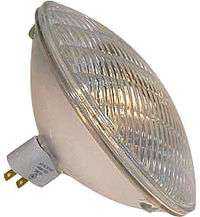Sealed beam

A sealed beam is a type of lamp with a parabolic reflector, one or more filaments, and a glass lens sealed permanently together as a unit. Originally introduced for road vehicle headlamp service, sealed beams have since been applied elsewhere. Halogen sealed beam lamps incorporate a halogen lamp within a quartz or hard glass envelope.
Sealed beams utilize a parabolic aluminized reflector, and are thus known as "PAR" lamps. Round PAR lamp diameter is expressed in eighths of an inch, so a PAR56 lamp, for example, is 56/8" (i.e., 7 inches) in diameter. Other popular sizes are PAR30, PAR36, PAR38, PAR46, and PAR64. Rectangular PAR lamp size is expressed in millimeters, so a PAR200×142 is 200 mm wide and 142 mm tall.
Sealed beams are available in a variety of nominal voltage ratings, most commonly 6, 12, 24, 28, 120, and 230 V. The actual operating voltage may differ from the nominal rated voltage; for example, "12 volt" sealed beam headlamps are meant for use in automobiles with typical line voltage of 13.5 to 14.2 with the engine running.
Automotive headlamps
Sealed beam headlamps were introduced in the United States in 1939, and became mandatory from the following year until the 1984 model year. Cars prior and after that date could have a variety of shapes of headlamps, using any of a wide variety of replaceable bulbs. Between 1940 and 1956, all U.S. cars had to have two 7-inch round headlights. [1]. Each headlight had dual filaments so that one bulb provided both high and low beam. In 1957, regulations changed to allowed four sealed beam headlights (two on each side, each measuring 5 ¾ in.). Two served as low and high beam like the 7” version, while the remaining two were additional “high beam” only Lamps. This influenced the overall design of the American-made vehicles. Halogen sealed beam headlamps appeared on U.S. cars in 1978 to enable halogen technology under Federal Motor Vehicle Safety Standard 108, which at the time required all headlamps to be of sealed beam construction; eventually, halogen sealed beams came to dominate the sealed beam lamp market.
The limited range of standardized sealed beam headlamp sizes and shapes restricted styling options for automobiles. Replaceable-bulb headlamps provide the regulated light distributions while allowing greater design and engineering freedom.[2]
Aircraft
Aircraft landing lights are often sealed beams that have a very narrow beam spread.
Building and stage lighting
In stage lighting, sealed beam lamps are often used. A common size, also used in rock concerts, as well as outdoor architectural lighting, is the parabolic aluminized reflector 64 (PAR64). PAR64 sealed beam lamps are typically available with 250, 500 or 1000 watt power ratings. The fixtures that such sealed beam lights go into are called "PAR cans". Beam spreads are designated as FL (flood), SP (spot), NSP (narrow spot), and VNSP (very narrow spot), as stamped on the back of the lamp's reflector.
Lighthouses
Sealed beam lamp arrays are also in use by modern lighthouses.[3]
References
- ↑ Grayen, Michael (22 April 2015). "A Brief History Of Sealed Beam Headlamps In The U.S." CARiD.com.
- ↑ Horst Bauer Bosch Automotive Handbook 4th Edition Robert Bosch GmbH, Stuttgart 1996 ISBN 0-8376-0333-1 page 710
- ↑ "The lights in Lighthouses". photographers-resource.co.uk. Retrieved 9 January 2011.